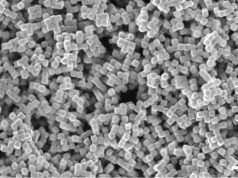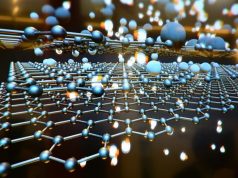A new concept for a flow battery functions like an old hourglass or egg timer, with particles (in this case carried as a slurry) flowing through a narrow opening from one tank to another. The flow can then be reversed by turning the device over.
Credit: Image courtesy of the researchers
A new approach to the design of a liquid battery, using a passive, gravity-fed arrangement similar to an old-fashioned hourglass, could offer great advantages due to the system’s low cost and the simplicity of its design and operation, says a team of MIT researchers who have made a demonstration version of the new battery.
Liquid flow batteries — in which the positive and negative electrodes are each in liquid form and separated by a membrane — are not a new concept, and some members of this research team unveiled an earlier concept three years ago. The basic technology can use a variety of chemical formulations, including the same chemical compounds found in today’s lithium-ion batteries. In this case, key components are not solid slabs that remain in place for the life of the battery, but rather tiny particles that can be carried along in a liquid slurry. Increasing storage capacity simply requires bigger tanks to hold the slurry.
But all previous versions of liquid batteries have relied on complex systems of tanks, valves, and pumps, adding to the cost and providing multiple opportunities for possible leaks and failures.
The new version, which substitutes a simple gravity feed for the pump system, eliminates that complexity. The rate of energy production can be adjusted simply by changing the angle of the device, thus speeding up or slowing down the rate of flow. The concept is described in a paper in the journal Energy and Environmental Science, co-authored by Kyocera Professor of Ceramics Yet-Ming Chiang, Pappalardo Professor of Mechanical Engineering Alexander Slocum, School of Engineering Professor of Teaching Innovation Gareth McKinley, and POSCO Professor of Materials Science and Engineering W. Craig Carter, as well as postdoc Xinwei Chen, graduate student Brandon Hopkins, and four others.
Find your dream job in the space industry. Check our Space Job Board »
Chiang describes the new approach as something like a “concept car” — a design that is not expected to go into production as it is but that demonstrates some new ideas that can ultimately lead to a real product.
The original concept for flow batteries dates back to the 1970s, but the early versions used materials that had very low energy-density — that is, they had a low capacity for storing energy in proportion to their weight. A major new step in the development of flow batteries came with the introduction of high-energy-density versions a few years ago, including one developed by members of this MIT team, that used the same chemical compounds as conventional lithium-ion batteries. That version had many advantages but shared with other flow batteries the disadvantage of complexity in its plumbing systems.
The new version replaces all that plumbing with a simple, gravity-fed system. In principle, it functions like an old hourglass or egg timer, with particles flowing through a narrow opening from one tank to another. The flow can then be reversed by turning the device over. In this case, the overall shape looks more like a rectangular window frame, with a narrow slot at the place where two sashes would meet in the middle.
In the proof-of-concept version the team built, only one of the two sides of the battery is composed of flowing liquid, while the other side — a sheet of lithium — is in solid form. The team decided to try out the concept in a simpler form before making their ultimate goal, a version where both sides (the positive and negative electrodes) are liquid and flow side by side through an opening while separated by a membrane.
Solid batteries and liquid batteries each have advantages, depending on their specific applications, Chiang says, but “the concept here shows that you don’t need to be confined by these two extremes. This is an example of hybrid devices that fall somewhere in the middle.”
The new design should make possible simpler and more compact battery systems, which could be inexpensive and modular, allowing for gradual expansion of grid-connected storage systems to meet growing demand, Chiang says. Such storage systems will be critical for scaling up the use of intermittent power sources such as wind and solar.
While a conventional, all-solid battery requires electrical connectors for each of the cells that make up a large battery system, in the flow battery only the small region at the center — the “neck” of the hourglass — requires these contacts, greatly simplifying the mechanical assembly of the system, Chiang says. The components are simple enough that they could be made through injection molding or even 3-D printing, he says.
In addition, the basic concept of the flow battery makes it possible to choose independently the two main characteristics of a desired battery system: its energy density (how much energy it can deliver at a given moment) and its power density (how much total power can be stored in the system). For the new liquid battery, the power density is determined by the size of the “stack,” the contacts where the battery particles flow through, while the energy density is determined by the size of its storage tanks. “In a conventional battery, the power and energy are highly interdependent,” Chiang says.
The trickiest part of the design process, he says, was controlling the characteristics of the liquid slurry to control the flow rates. The thick liquids behave a bit like ketchup in a bottle — it’s hard to get it flowing in the first place, but then once it starts, the flow can be too sudden. Getting the flow just right required a long process of fine-tuning both the liquid mixture and the design of the mechanical structures.
The rate of flow can be controlled by adjusting the angle of the device, Chiang says, and the team found that at a very shallow angle, close to horizontal, “the device would operate most efficiently, at a very steady but low flow rate.” The basic concept should work with many different chemical compositions for the different parts of the battery, he says, but “we chose to demonstrate it with one particular chemistry, one that we understood from previous work. We’re not proposing this particular chemistry as the end game.”
The work was supported by the Joint Center for Energy Storage Research, funded by the U.S. Department of Energy. The team also included graduate students Ahmed Helal and Frank Fan, and postdocs Kyle Smith and Zheng Li.
Source: Massachusetts Institute of Technology
The original item was written by David L. Chandler.
Journal Reference:
- Xinwei Chen, Brandon J. Hopkins, Ahmed Helal, Frank Y. Fan, Kyle C. Smith, Zheng Li, Alexander H. Slocum, Gareth H. McKinley, W. Craig Carter, Yet-Ming Chiang. A low-dissipation, pumpless, gravity-induced flow battery. Energy Environ. Sci., 2016; 9 (5): 1760 DOI:10.1039/C6EE00874G











